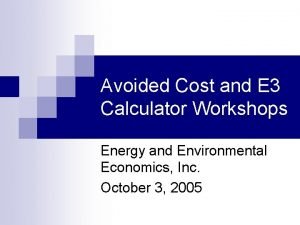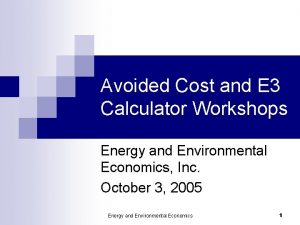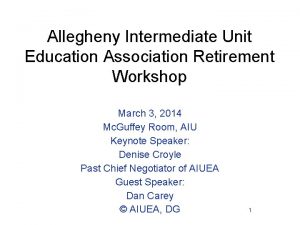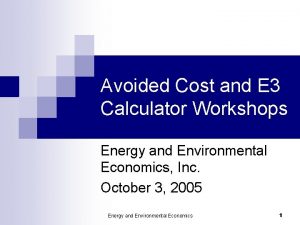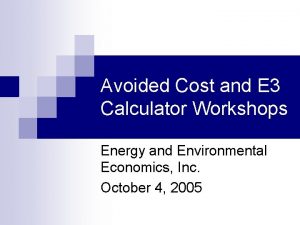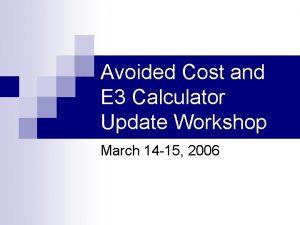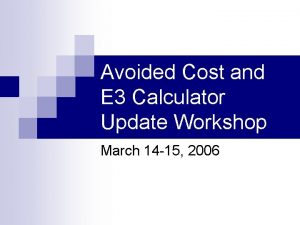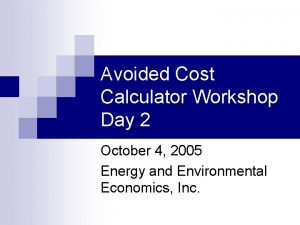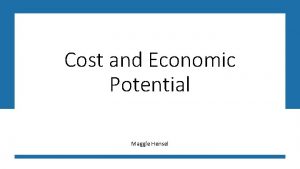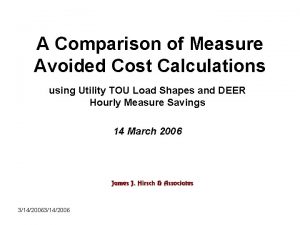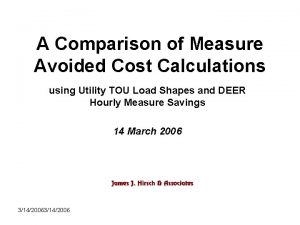Avoided Cost and E 3 Calculator Workshops Energy













- Slides: 13

Avoided Cost and E 3 Calculator Workshops Energy and Environmental Economics, Inc. October 4, 2005

Total Electric Avoided Costs Shape is Based on PG&E’s San Jose Planning Division

Refinements in Avoided Cost n n n Background Overview of Title 24 DR Progress Focus on demand response measures ¨ Programmable n Communicating Thermostat example Capacity and Energy Value Refinement ¨ Existing CPUC and CEC TDV Values are based on 1998 and 1999 PX market data ¨ Proposed new method modifies the PX market shape based on a ‘CT Backstop’ approach ¨ Creates a ‘peakier’ value curve

Background n n n 2005 Title 24 Building Standards adopted ‘Timedependent Valuation’ methodology Analysis was completed in 2003, and much information was used in the CPUC Avoided Cost proceeding started in 2004 2008 Title 24 Building Standards are evaluating a new TDV curve for demand response ¨ Refinement in energy and capacity valuation

Overview of Title 24 DR Progress n n 3 Public Meetings Completed Methodology Components ¨ Energy, reliability, and capacity most difficult ¨ T&D, environment, other pieces adopted from CEC Title 24 TDV and CPUC Avoided Costs n prior Attempt at party consensus of approach ¨ CEC, SCE, PG&E, SDG&E ¨ Public comment also requested n Proposal for complete methodology has been developed – remainder of presentation

Title 24 2008 Energy and Capacity Value Method and results in this slide are preliminary.

Value of Energy, Capacity, Reliability Resource Planning Dk. W of Equivalent Capacity in Each Hour + + Operations Class Average VOS $25/k. Wh -Productivity -$5/k. W Net Reliability $20/k. Wh Additional Dk. W of Equivalent Capacity Achieved During Stage 3

CT Backstop Method Modifies the historical market price shape to reflect avoiding the need to add capacity n Assumes that the backstop technology to add capacity in the State is a CT n Observed market prices will pay for part, but not the total costs of a new CT n ¨ Differe

CEC Price Shape – 2004 IEPR Note these shapes are from 2004 IEPR.

Forecast Market Price - 2008 n n n CEC Shape Scaled to All-in Combined Cycle Cost Price Duration Curve

Calculation of Residual Capacity Value n Uses $72/k. W-year Fixed Cost of a CT Assumption (levelized real) ¨ n n $85/k. W-year (levelized nominal) approx. the same value. Result is approximately $20/k. W-yr High number of operating hours Similar analyses for other cases / utilities show approximately 700900 hours operation Few hours results in a larger residual capacity value

Allocation of Residual Capacity Control Area Load 1999 Example Resulting Allocators

Energy and Capacity Curve (Example from 2008) Residual Capacity – 100 Hours Residual Capacity – 250 Hours
 Avoided cost calculator
Avoided cost calculator Sce tou calculator
Sce tou calculator Read 180 workshops
Read 180 workshops Psea retirement workshops
Psea retirement workshops Curious george mbti
Curious george mbti Cramped workshops set up in shabby tenement buildings
Cramped workshops set up in shabby tenement buildings Workshops glutenvrij
Workshops glutenvrij Workshops for rectors
Workshops for rectors Oracle licensing workshops
Oracle licensing workshops Social thinking workshops
Social thinking workshops Nature explore workshops
Nature explore workshops Google anay
Google anay Canadian bioinformatics workshops
Canadian bioinformatics workshops Canadian bioinformatics workshops
Canadian bioinformatics workshops
